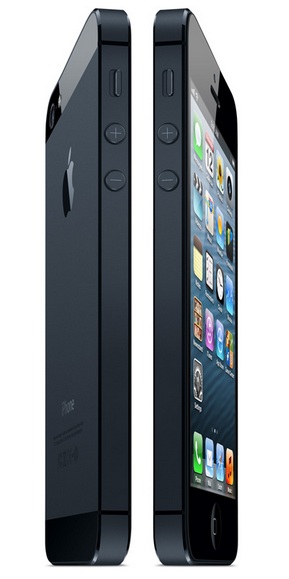The Five Things From Apple's iPhone 5 Launch That CIOs Will Care About
There was a ton of news from Apple's event today, many of which may have sounded earthshattering to those nattering away on Twitter (raises hand), but upon more reflection, are probably irrelevant to those of us in the enterprise and business worlds.
Skittles Rainbow of colors for new iPod Touch? Leave that for the kids.
New and improved EarPods? Interesting to audiophiles and ear-ergonomics geeks, if there is such a thing (ooh, there is).
Even the news that the iPhone 5 would have a slightly-larger (4-inch) screen with the odd-duck resolution of 1136 x 640? Really only important to designers and other UI geeks.

"Yay, I'm 18% skinner than before!"
Instead, I've tried to curate the news that I think will matter to enterprises and their mobile champions.
Updated: I've also added a 6th point at the bottom about new features in iOS6 that were not discussed in detail during the launch.
1) Continued iPad momentum
- 84 million iPads sold to date, including 17 million sold in calendar Q2
- iPad global tablet market share = 68%, up from 62% last year (according to Apple)
- 94% of the Fortune 500 are testing or deploying iPads. While that sounds high, let's note that that figure has barely budged from the 92% testing/deploying iPads figure that Tim Cook said one year ago. Though based on the strong iPad sales, I'd guess that the balance of deployments vs. tests has shifted towards the former.
POV: The iPad train is chugging along even faster than ever. Android's growing, and Windows 8 will be big, but they won't challenge overnight.
2) Field service workers and business travelers to benefit from iPhone 5's much-better networking
- Broadband cellular options now include LTE from about 20 carriers around the world, as well as DC-HSDPA, HSPA+, HSPA, EV-DO, EDGE and GPRS all from the same chip
- LTE carriers: AT&T, Verizon, and Sprint (US); Bell, Rogers, Telus, Fido, Virgin Mobile, and Koodo (Canada); Everything Everywhere (UK); T-Mobile (Germany); SoftBank and KDDI (Japan); SKT and KT (Korea); SmarTone (Hong Kong); and SingTel (Singapore).
POV: This is important because fast cellular data makes the following apps either perform much better or suddenly practical at all:
- Big Data and analytics-dependent apps;
- Apps that can benefit from FaceTime-based videoconferencing (imagine a paramedic showing wounds to a doctor before arriving to hospital, or a service technician getting live help on a repair from an expert back at headquarters);
- Any apps where data must reside on server for security reasons.
3) Better camera and multimedia also a boon for enterprise field workers
- 3 microphones for better sound outdoors and/or windy conditions
- noise-cancelling earpiece
- 8 megapixel rear-side camera with 1080p video
- 720p front (user)-facing camera for high-res FaceTime videoconferencing
POV: Honestly, these are all small incremental upgrades. But as Carolina Milanesi, Gartner analyst, wisely put it: "Apple remains the only vendor that through incremental improvements delivers a considerably richer experience. 1+1 sometimes can be 3."
My main quibble is that the 4-inch screen is such a minor upgrade. As a tall person (6'3"), I would love a device the size of a Samsung Galaxy Tab, HTC One X or even a Samsung Galaxy Note. Hey Apple - if you can bring yourself to consider a shrunken iPad, how about a supersized iPhone?
4) ...On the other hand, iPhone 5 fails to significantly improve battery life
Here's what Apple says:
8 hours: 3G talk time, 3G web browsing, or LTE-enabled Web browsing
10 hours: Wi-Fi browsing or video
225 hours: Standby
POV: Apple's continuing to favor sleek design and new features over longer battery life. That's ok for most users, the semi-mobile knowledge workers like myself. But it's not great for actual field service workers and heavy business travelers, from whom I've heard many a complaint. Fortunately, there are many add-on products - car chargers, battery packs, etc. - to provide them relief.
5) Ecosystem and developers keep growing
- 400 million iOS devices sold through June 2012
- 250,000 apps tailored specifically for the iPad
- Apple demos apps from GE Capital, Mayo Clinic and Ducati. Cook asserts that businesses using iPads are "investing in custom apps. This is something none of them do on the PC."
POV: Again, another smash aimed across the net at Redmond. It's obviously hyperbole. There are millions of Microsoft enterprise developers and they are constantly building custom apps for Windows, Office, SharePoint, etc.
The problem is the fragmentation - how many of these Microsoft devs will eagerly start building for Windows RT or Windows 8 in the near future? I think most will wait until enterprises make major deployments, and that traditionally takes 2-3 years after an OS's release for PCs.
Bonus: iOS 6 augments device and app management
Details about enterprise improvements in iOS 6, due to be released September 19 (which SAP will soon support), have slowly leaked out over the summer, but were not really discussed today.
Thanks to Adam Stein, senior director for mobile product marketing at SAP, who calls these the two of the top improvements in iOS 6 around MDM and MAM (Mobile App Management):
- New “Authorized Mode” lets Enterprises use the Apple configurator utility to pre-load Apps via MDM payload. Once loaded on the iOS device, Enterprise IT staff can remotely instruct the device to enable/disable a particular app based upon user policy compliance or permissions.
- Similarly, “Guided Access” via Authorized Mode helps retail, field service and education users lock and load an iOS app by triple clicking the Apple home button. Once Guided Access is enabled the device runs only the current application and is passcode protected from other functions essentially becoming a kiosk. Guided Access can also restrict touch input on certain areas of the screen.